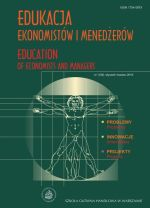Treść głównego artykułu
Abstrakt
The aim of the article is to present barriers to human capital development in Poland. The research was carried out on 941 respondents, from medium and large companies categorized as knowledge-intensive service (KIS), less-knowledge intensive service (LKIS) and production. The research indicates the following barriers: lack of financial resources, higher priority of other issues/projects/investments, lack of time for developmental actions, lack of consciousness of Board members and managers concerning the importance of development, lack of employees’ eagerness to learn, organizational culture resistant to change.
Słowa kluczowe
Szczegóły artykułu
Autor (Autorzy) artykułu oświadcza, że przesłane opracowanie nie narusza praw autorskich osób trzecich. Wyraża zgodę na poddanie artykułu procedurze recenzji oraz dokonanie zmian redakcyjnych. Przenosi nieodpłatnie na Oficynę Wydawniczą SGH autorskie prawa majątkowe do utworu na polach eksploatacji wymienionych w art. 50 Ustawy z dnia 4 lutego 1994 r. o prawie autorskim i prawach pokrewnych – pod warunkiem, że praca została zaakceptowana do publikacji i opublikowana.
Oficyna Wydawnicza SGH posiada autorskie prawa majątkowe do wszystkich treści czasopisma. Zamieszczenie tekstu artykuły w repozytorium, na stronie domowej autora lub na innej stronie jest dozwolone o ile nie wiąże się z pozyskiwaniem korzyści majątkowych, a tekst wyposażony będzie w informacje źródłowe (w tym również tytuł, rok, numer i adres internetowy czasopisma).
Osoby zainteresowane komercyjnym wykorzystaniem zawartości czasopisma proszone są o kontakt z Redakcją.
![]()
Referencje
-
1. Cahuc P., Zylberberg A., Labor economics, MIT 2004.
2. Cameron K.S., Quinn R.E., Kultura organizacyjna – diagnoza i zmiana, Oficyna Ekonomiczna, Kraków 2003.
3. Coyle-Shapiro J.A.M., Conway N., Exchange relationships: examining psychological contracts and perceived organizational support, “Journal of Applied Psychology” 2005, Vol. 90.
4. Eisenberger R., Huntington R., Hutchison S., Sowa D., Perceived organizational support, “Journal of Applied Psychology” 1986, Vol. 71.
5. Hartog J., Van den Brink H.M., Human Capital. Theory and evidence, Cambridge University Press, 2007.
6. Improving Organizational Effectiveness through Transformational Leadership, Eds. B.M. Bass, B.J. Avolio, Sage Publications, Thousand Oaks, CA 1994.
7. Jorgensen F., Becker K., Matthews J., The HRM Practices of Innovative Knowledge-Intensive Firms, “International Journal of Technology Management” 2011, Vol. 56, Issue 2.
8. Kossowska M., Umysł niezmienny… Poznawcze mechanizmy sztywności, Wyd. UJ, Kraków 2005.
9. Martin M.M., Cayanus J.L., McCutcheon L.E., Maltby J., Celebrity Worship and Cognitive Flexibility, “North American Journal of Psychology” 2003, Vol. 5, No. 1.
10. Rank J., Nelson N., Allen T., Xu X., Leadership Predictors of Innovation and Task Performance: Subordinates’ Self-esteem and Self-presentation as Moderators, “Journal of Occupational and Organizational Psychology“ 2009, No. 82.
11. Rao T.V., Be your own HR manager, presentation at the conference “International HRM Conference Dream, Discover, Dare, Innovations in the Global Village: Role of International HRM”, India 2012.
12. Reuvers M., van Engel M.L., Vinkenburg C.J., Wilson-Evered E., Transformational Leadership and Innovative Behaviour: Exploring the Relevance of Gender Differences, “Creativity and Innovation Management” 2008, Vol. 17, No. 2.
13. Społeczeństwo w drodze do wiedzy. Raport o stanie edukacji 2010, Instytut Badań Edukacyjnych, Warszawa 2011.
14. Szczucka A., Turek K., Worek B., Kształcenie po szkole. Uczenie się dorosłych, inwestycje w kadry w przedsiębiorstwach, instytucje szkoleniowe, Bilans Kapitału Ludzkiego, Uniwersytet Jagielloński, PARP, Warszawa 2012, http://bkl.parp. gov.pl/system/files/Downloads/20120425224717/Kszta_cenie_po_szkole. pdf?1335387612.
15. Trompenaars F., Kultura innowacji. Kreatywność pracowników a sukces firmy, Oficyna a Wolters Kluwer business, Warszawa 2010.
16. Wojtczuk-Turek A., Elastyczność organizacyjna i indywidualna a zachowania innowacyjne w miejscu pracy – empiryczna analiza zależności, in: Sukces w zarządzaniu kadrami. Elastyczność w zarządzaniu kapitałem ludzkim, „Prace Naukowe Uniwersytetu Ekonomicznego we Wrocławiu” Eds. S.A. Witkowski, M. Stor, 2012, No. 249.
Referencje
2. Cameron K.S., Quinn R.E., Kultura organizacyjna – diagnoza i zmiana, Oficyna Ekonomiczna, Kraków 2003.
3. Coyle-Shapiro J.A.M., Conway N., Exchange relationships: examining psychological contracts and perceived organizational support, “Journal of Applied Psychology” 2005, Vol. 90.
4. Eisenberger R., Huntington R., Hutchison S., Sowa D., Perceived organizational support, “Journal of Applied Psychology” 1986, Vol. 71.
5. Hartog J., Van den Brink H.M., Human Capital. Theory and evidence, Cambridge University Press, 2007.
6. Improving Organizational Effectiveness through Transformational Leadership, Eds. B.M. Bass, B.J. Avolio, Sage Publications, Thousand Oaks, CA 1994.
7. Jorgensen F., Becker K., Matthews J., The HRM Practices of Innovative Knowledge-Intensive Firms, “International Journal of Technology Management” 2011, Vol. 56, Issue 2.
8. Kossowska M., Umysł niezmienny… Poznawcze mechanizmy sztywności, Wyd. UJ, Kraków 2005.
9. Martin M.M., Cayanus J.L., McCutcheon L.E., Maltby J., Celebrity Worship and Cognitive Flexibility, “North American Journal of Psychology” 2003, Vol. 5, No. 1.
10. Rank J., Nelson N., Allen T., Xu X., Leadership Predictors of Innovation and Task Performance: Subordinates’ Self-esteem and Self-presentation as Moderators, “Journal of Occupational and Organizational Psychology“ 2009, No. 82.
11. Rao T.V., Be your own HR manager, presentation at the conference “International HRM Conference Dream, Discover, Dare, Innovations in the Global Village: Role of International HRM”, India 2012.
12. Reuvers M., van Engel M.L., Vinkenburg C.J., Wilson-Evered E., Transformational Leadership and Innovative Behaviour: Exploring the Relevance of Gender Differences, “Creativity and Innovation Management” 2008, Vol. 17, No. 2.
13. Społeczeństwo w drodze do wiedzy. Raport o stanie edukacji 2010, Instytut Badań Edukacyjnych, Warszawa 2011.
14. Szczucka A., Turek K., Worek B., Kształcenie po szkole. Uczenie się dorosłych, inwestycje w kadry w przedsiębiorstwach, instytucje szkoleniowe, Bilans Kapitału Ludzkiego, Uniwersytet Jagielloński, PARP, Warszawa 2012, http://bkl.parp. gov.pl/system/files/Downloads/20120425224717/Kszta_cenie_po_szkole. pdf?1335387612.
15. Trompenaars F., Kultura innowacji. Kreatywność pracowników a sukces firmy, Oficyna a Wolters Kluwer business, Warszawa 2010.
16. Wojtczuk-Turek A., Elastyczność organizacyjna i indywidualna a zachowania innowacyjne w miejscu pracy – empiryczna analiza zależności, in: Sukces w zarządzaniu kadrami. Elastyczność w zarządzaniu kapitałem ludzkim, „Prace Naukowe Uniwersytetu Ekonomicznego we Wrocławiu” Eds. S.A. Witkowski, M. Stor, 2012, No. 249.
